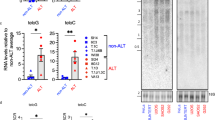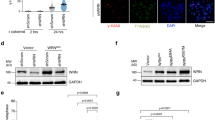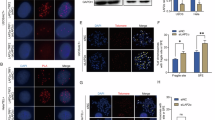Abstract
Telomeres are essential for cell survival and have been implicated in the mitotic control. The telomeric protein Pin2/TRF1 controls telomere elongation and its expression is tightly regulated during cell cycle. We previously reported that overexpression of Pin2/TRF1 affects mitotic progression. However, the role of Pin2/TRF1 at the interface between cell division and cell survival remains to be determined. Here we show that overexpression of Pin2 induced apoptosis in cells containing short telomeres, but not in cells with long telomeres. Furthermore, before entering apoptosis, Pin2-expressing cells first accumulated in mitosis and strongly stained with the mitosis-specific MPM2 antibody. Moreover, Pin2-induced apoptosis is potentiated by arresting cells in mitosis, but suppressed by accumulating cells in G1. In addition, overexpression of Pin2 also resulted in activation of caspase-3, and its proapoptotic activity was significantly reduced by inhibition of caspase-3. These results indicate that up-regulation of Pin2/TRF1 can specifically induce entry into mitosis and apoptosis, likely via a mechanism related to activation of caspase-3. Significantly, we also found that, out of 51 human breast cancer tissues and 10 normal controls examined, protein levels of Pin2/TRF1 in tumors were significantly lower than in normal tissues, as detected by immunoblotting analysis and immunocytochemistry. Since down-regulation of Pin2/TRF1 allows cells to maintain long telomeres, these results suggest that down-regulation of Pin2/TRF1 may be important for cancer cells to extend their proliferative potential.
This is a preview of subscription content, access via your institution
Access options
Subscribe to this journal
Receive 50 print issues and online access
$259.00 per year
only $5.18 per issue
Buy this article
- Purchase on SpringerLink
- Instant access to full article PDF
Prices may be subject to local taxes which are calculated during checkout







Similar content being viewed by others
References
Ahmad K, Golic KG . 1999 Genetics 151: 1041–1051
Aragona M, Buda CA, Panetta S, Morelli M, Giudice A, Campagna FL, Pontoriero A, Cascinu S, La Torre F . 2000 Oncol. Rep. 7: 987–990
Barlow C, Hirotsune S, Paylor R, Liyanage M, Eckhaus M, Collins F, Shiloh Y, Crawley JN, Ried T, Tagle D, Wynshaw BA . 1996 Cell 86: 159–171
Beamish H, Khanna KK, Lavin MF . 1994 Radiat Res S130–S133
Belloc F, Belaud-Rotureau MA, Lavignolle V, Bascans E, Braz-Pereira E, Durrieu F, Lacombe F . 2000 Cytometry 40: 151–160
Chikashige Y, Ding DQ, Funabiki H, Haraguchi T, Mashiko S, Yanagida M, Hiraoka Y . 1994 Science 264: 270–273
Chong L, van SB, Broccoli D, Erdjument BH, Hanish J, Tempst P, de Lange T . 1995 Science 270: 1663–1667
Cooper JP, Nimmo ER, Allshire RC, Cech TR . 1997 Nature 385: 744–747
Cryns V, Yuan J . 1998 Genes Dev. 12: 1551–1570
Davis FM, Tsao TY, Fowler SK, Rao PN . 1983 Proc. Natl. Acad. Sci. USA 80: 2926–2930
Douglas RS, Pletcher Jr CH, Nowell PC, Moore JS . 1998 Cytometry 32: 57–65
Elson A, Wang Y, Daugherty CJ, Morton CC, Zhou F, Campos-Torres J, Leder P . 1996 Proc. Natl. Acad. Sci. USA 93: 13084–13089
Fu W, Begley JG, Killen MW, Mattson MP . 1999 J. Biol. Chem. 274: 7264–7271
Funabiki H, Hagan I, Uzawa S, Yanagida M . 1993 J. Cell Biol. 121: 961–976
Gavrieli Y, Sherman Y, Ben-Sasson SA . 1992 J. Cell. Biol. 119: 493–501
Greenwell PW, Kronmal SL, Porter SE, Gassenhuber J, Obermaier B, Petes TD . 1995 Cell 82: 823–829
Greider CW, Blackburn EH . 1996 Sci. Am. 274: 92–97
Hahn WC, Stewart SA, Brooks MW, York SG, Eaton E, Kurachi A, Beijersbergen RL, Knoll JH, Meyerson M, Weinberg RA . 1999 Nat. Med. 5: 1164–1170
Herbert B, Pitts AE, Baker SI, Hamilton SE, Wright WE, Shay JW, Corey DR . 1999 Proc. Natl. Acad. Sci. USA. 96: 14276–14281
Ishibashi T, Lippard SJ . 1998 Proc. Natl. Acad. Sci. USA. 95: 4219–4223
Jakobisiak M, Bruno S, Skierski JS, Darzynkiewicz Z . 1991 Proc. Natl. Acad. Sci. USA. 88: 3628–3632
Karlseder J, Broccoli D, Dai Y, Hardy S, de Lange T . 1999 Science 283: 1321–1325
Keyomarsi K, Sandoval L, Band V, Pardee AB . 1991 Cancer Res. 51: 3602–3609
Kirk KE, Harmon BP, Reichardt IK, Sedat JW, Blackburn EH . 1997 Science 275: 1478–1481
Kondo S, Kondo Y, Li G, Silverman RH, Cowell JK . 1998a Oncogene 16: 3323–3330
Kondo S, Tanaka Y, Kondo Y, Hitomi M, Barnett GH, Ishizaka Y, Liu J, Haqqi T, Nishiyama A, Villeponteau B, Cowell JK, Barna BP . 1998b FASEB J. 12: 801–811
Kondo Y, Kondo S, Tanaka Y, Haqqi T, Barna BP, Cowell JK . 1998c Oncogene 16: 2243–2248
Konig P, Giraldo R, Chapman L, Rhodes D . 1996 Cell 85: 125–136
Krauskopf A, Blackburn EH . 1996 Nature 383: 354–357
Kumar S, Kinoshita M, Noda M, Copeland NG, Jenkins NA . 1994 Genes Dev. 8: 1613–1626
Lee HW, Blasco MA, Gottlieb GJ, Horner JWN, Greider CW, DePinho RA . 1998 Nature 392: 569–574
Lu KP . 2000 Prog. Cell Cycle Res. 4: 83–96
Lu KP, Hanes SD, Hunter T . 1996 Nature 380: 544–547
Lu KP, Hunter T . 1995 Cell 81: 413–424
Lu PJ, Wulf G, Zhou XZ, Davies P, Lu KP . 1999a Nature 399: 784–788
Lu PJ, Zhou XZ, Shen M, Lu KP . 1999b Science 283: 1325–1328
Lundblad V . 2000 Mutat Res. 451: 227–240
Marcand S, Gilson E, Shore D . 1997 Science 275: 986–990
Matsumoto-Taniura N, Pirollet F, Monroe R, Gerace L, Westendorf JM . 1996 Mol. Biol. Cell 7: 1455–1469
Mayo MW, Wang CY, Cogswell PC, Rogers-Graham KS, Lowe SW, Der CJ, Baldwin Jr AS . 1997 Science 278: 1812–1815
McEachern MJ, Blackburn EH . 1995 Nature 376: 403–409
Metcalfe JA, Parkhill J, Campbell L, Stacey M, Biggs P, Byrd PJ, Taylor AM . 1996 Nat. Genet. 13: 350–353
Nicholson DW, Ali A, Thornberry NA, Vaillancourt JP, Ding CK, Gallant M, Gareau Y, Griffin PR, Labelle M, Lazebnik YA, Munday NA, Raju SM, Smulson ME, Yamin TT, Yu VL, Miller DK . 1995 Nature 376: 37–43
Pandita TK, Pathak S, Geard CR . 1995 Cytogenet Cell Genet. 71: 86–93
Rudolph NS, Latt SA . 1989 Mutat Res. 211: 31–41
Sanchez Y, Desany BA, Jones WJ, Liu Q, Wang B, Elledge SJ . 1996 Science 271: 357–360
Sandell LL, Zakian VA . 1993 Cell 75: 729–739
Savitsky K, Bar SA, Gilad S, Rotman G, Ziv Y, Vanagaite L, Tagle DA, Smith S, Uziel T, Sfez S, Ashkenazi M, Pecker I, Frydman M, Harnik R, Patanijali SR, Simmons A, Clines GA, Sartiel A, Gatti RA, Chessa L, Sanal O, Lavin MF, Jasper NGJ, Taylor AMR, Arlett CF, Miki T, Weissman SM, Lovett M, Collin FC, Shiloh Y . 1995 Science 268: 1749–1753
Shen M, Haggblom C, Vogt M, Hunter T, Lu KP . 1997 Proc. Natl. Acad. Sci. USA 94: 13618–13623
Shen M, Stukenberg PT, Kirschner MW, Lu KP . 1998 Genes Dev. 12: 706–720
Smilenov LB, Morgan SE, Mellado W, Sawant SG, Kastan MB, Pandita TK . 1997 Oncogene 15: 2659–2665
van Steensel B, de Lange T . 1997 Nature 385: 740–743
Vandre DD, Davis FM, Rao PN, Borisy GG . 1986 Eur. J. Cell. Biol. 41: 72–81
Westendorf JM, Rao PN, Gerace L . 1994 Proc. Natl. Acad. Sci. USA 91: 714–718
Xia SJ, Shammas MA, Shmookler RJ . 1996 Mutat. Res. 364: 1–11
Xu Y, Ashley T, Brainerd EE, Bronson RT, Meyn MS, Baltimore D . 1996 Gene. Dev. 10: 2411–2422
Xu Y, Baltimore D . 1996 Gene. Dev. 10: 2401–2410
Yaffe MB, Schutkowski M, Shen M, Zhou XZ, Stukenberg PT, Rahfeld J, Xu J, Kuang J, Kirschner MW, Fischer G, Cantley LC, Lu KP . 1997 Science 278: 1957–1960
Young AC, Chavez M, Giambernardi TA, Mattern V, McGill JR, Harris JM, Sarosdy MF, Patel P, Sakaguchi AY . 1997 Somat. Cell. Mol. Genet. 23: 275–286
Zakian VA . 1995 Science 270: 1601–1607
Zhang X, Mar V, Zhou W, Harrington L, Robinson MO . 1999 Genes. Dev. 13: 2388–2399
Zhou XZ, Kops O, Werner A, Lu PJ, Shen M, Stoller G, Küllertz G, Stark M, Fischer G, Lu KP . 2000 Mol. Cell. 6: 873–883
Zhu L, van den Heuvel S, Helin K, Fattaey A, Ewen M, Livingston D, Dyson N, Harlow E . 1993 Genes. Dev 1111–1125
Ziv Y, Jaspers NG, Etkin S, Danieli T, Trakhtenbrot L, Amiel A, Ravia Y, Shiloh Y . 1989 Cancer Res. 49: 2495–2501
Acknowledgements
We thank B Neel, L Cantley, J Yuan and Y Shiloh for constructive discussion, G Wulf for providing the human breast cancer tissues, T de Lange for long telomere HeLa cells, T Niu for helping statistical analysis and Y Shiloh for the A-T cell line. G Wulf and M Nakamura are a DOD Breast Cancer Program and a Human Frontier Research Program fellows, respectively. KP Lu is a Pew Scholar and a Lymphoma and Leukemia Society Scholar. The work was supported by grants from Nathan Shock Center on Aging and NIH (R01GM56230) to KP Lu.
Author information
Authors and Affiliations
Rights and permissions
About this article
Cite this article
Kishi, S., Wulf, G., Nakamura, M. et al. Telomeric protein Pin2/TRF1 induces mitotic entry and apoptosis in cells with short telomeres and is down-regulated in human breast tumors. Oncogene 20, 1497–1508 (2001). https://doi.org/10.1038/sj.onc.1204229
Received:
Revised:
Accepted:
Issue Date:
DOI: https://doi.org/10.1038/sj.onc.1204229



